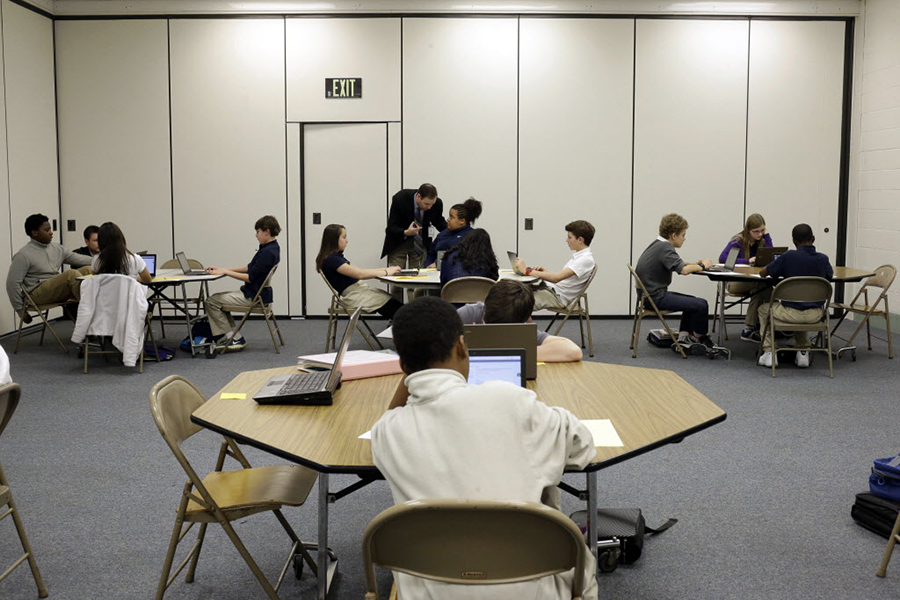Applause for No Child Left Behind rewrite, but concerns remain
Loading...
A bipartisan Senate bill to rewrite the Elementary and Secondary Education Act (ESEA), currently known as No Child Left Behind, took a big leap forward Thursday. The legislation passed out of the Senate Committee on Health, Education, Labor & Pensions unanimously, after members considered 57 amendments over the course of several days.
Now dubbed the Every Child Achieves Act of 2015, the legislation would continue to require the current level of testing in reading, math, and science. It also would require the reporting of data for subgroups of students according to categories such as race, gender, income, and disability. But it would allow states to set up their own accountability systems. Although states must work toward improving their lowest-performing schools overall, they would no longer be required to intervene in schools where students in various subgroups have fallen behind.
The “consensus is this: Continue the law’s important measurements of academic progress of students but restore to states, school districts, classroom teachers and parents the responsibility for deciding what to do about improving student achievement,” said committee chairman Lamar Alexander (R) of Tennessee in a statement. He and the top Democrat on the committee, Sen. Patty Murray of Washington, negotiated the meat of the bill over the past several weeks and received widespread praise from various stakeholders for forging a compromise.
“On the Democratic side, they really drew the line at keeping the annual standardized testing regime and reporting disaggregated subgroup data, and they got that. What Republicans wanted was to loosen up a lot on the accountability and school-improvement [requirements], and they got that,” says Patrick McGuinn, a political science professor at Drew University in Madison, N.J.
Yet the compromise means that few policy groups are fully satisfied with the bill in its current form. And debate in the full Senate, which hasn’t yet been scheduled, is likely to spark some partisan fireworks over issues ranging from vouchers to the level of the power the US Department of Education should have when it comes to ensuring schools are improved for disadvantaged students.
Secretary of Education Arne Duncan applauded the bill for allowing states and districts to use federal education dollars to improve early-childhood education, but he joined various civil rights and business groups in calling for accountability measures to be strengthened.
One of those groups is The Leadership Conference on Civil and Human Rights, which joined 40 other organizations in sending a letter to Senator Alexander critiquing the bill earlier this week.
“We refuse to stand by and watch the fragile progress we’ve made in holding schools accountable for educating vulnerable students wither away,” said Nancy Zirkin, executive vice president for The Leadership Conference, in a statement Thursday.
Advocates of stronger accountability for high schools were disappointed that amendments did not pass that would have required states to identify schools with low graduation rates, give them more support, and set graduation-rate improvement goals. The bill does require transparent reporting of graduation rates, however.
“With more than 1,200 high schools still graduating less than two-thirds of their students, now is not the time to be tough on data and weak on action,” said Bob Wise, president of the Alliance for Excellent Education and former governor of West Virginia. “Of the more than 1.1 million students attending these schools, most are students of color and low-income students.”
Still, the bill received overall praise from groups ranging from the National School Boards Association – which said it marked a victory for local control – to the National Alliance for Public Charter Schools, which likes provisions for supporting the growth of high-quality charter schools.
The bill also includes support for magnet schools, which advocates of racial and socioeconomic integration say have a good track record for furthering such goals because they draw students voluntarily from a wide variety of neighborhoods.
The bill rolls back current federal power in several ways: It affirms state control over standards and does not allow the federal government to mandate or incentivize the adoption of certain standards, including Common Core.
It also takes away any federal definition for “highly qualified teachers,” allowing states to define that. And states would not be required to mandate teacher evaluation systems. Such systems are also not required under No Child Left Behind, but they have been pushed as part of the waivers that many states have sought from the US Department of Education to obtain some relief from NCLB requirements.
Two of the amendments passed by the Senate committee this week acknowledged growing public concern about students being overtested. One allows states to use federal funds to examine the quality and quantity of testing and eliminate low-quality tests, while the other would ensure that the federal law cannot preempt local or state laws that allow parents to opt out of testing for their children, Education Week reports.
If the bill passes the Senate, then there’s the question of what will happen in the House. That “would be a much more formidable battle,” Professor McGuinn says. Another option would be for the House to take a vote on the version sponsored by Education Committee chairman John Kline (R) of Minnesota and then try to work out a compromise with the Senate. When it passed out of committee, that legislation had the backing of only Republicans (and not all of them).
A third option, the least optimistic scenario for those hoping to see something get through Congress this year: “They can do nothing and allow the Senate bill to die, thus almost certainly dooming ESEA reauthorization until well after the 2016 election,” writes Michael Petrilli, president of the Thomas B. Fordham Institute.
But for now, plenty of people are celebrating the momentum created this week by the Senate HELP committee. The agreement they reached “is so rare that the crowd still on hand on the third day of markup applauded” when the unanimous vote finally took place, CQ Roll Call reports.








